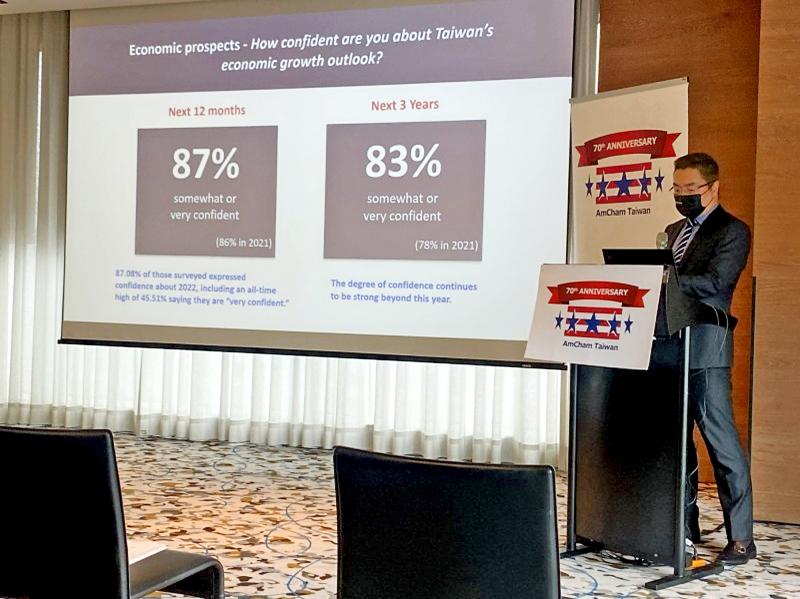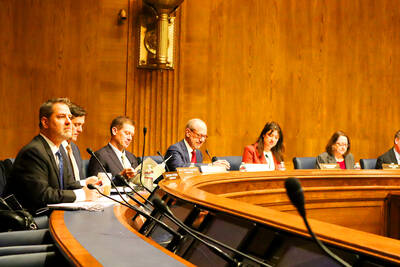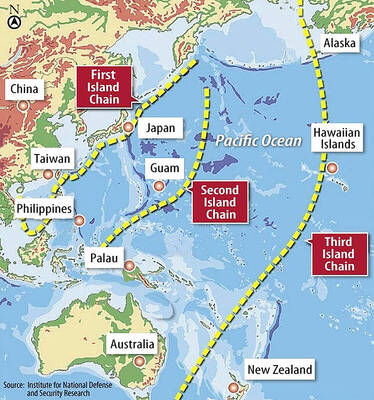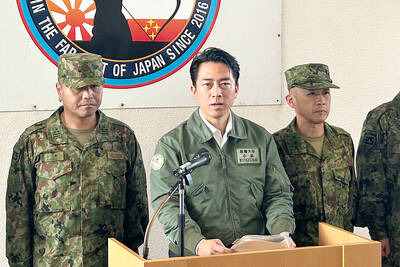A record 90 percent of US companies in Taiwan expect revenue growth this year, while many want the government to prioritize energy issues to ensure sufficient supply and stable voltage, the American Chamber of Commerce in Taiwan (AmCham) said yesterday.
While last year was challenging for the global economy, Taiwan demonstrated its resilience with an impressive economic performance, the chamber of 1,050 members from 500 international companies said in a survey it conducted last month and this month.
GDP growth is likely to fare well again this year, as demand for Taiwanese exports remains sturdy, it said.

Photo: Huang Pei-chun, Taipei Times
Consistent with this trend, the annual business climate survey indicated high levels of optimism among member companies regarding the economic outlook.
Among the respondents, more than 87 percent expressed confidence in Taiwan’s economic growth over the next 12 months, while 83 percent were positive about the outlook over the next three years, the AmCham said.
Taiwan’s stable economy has prompted a record 90 percent of members to indicate confidence in their revenue growth prospects over the next 12 months, with 91 percent confident over a three-year span, it said.
Sixty-one percent said that President Tsai Ing-wen (蔡英文) should give top priority to the energy issue, followed by COVID-19 pandemic control (46 percent), cross-strait relations (42 percent), and trade agreements with the US and other partners (42 percent), the survey showed.
On the energy front, a majority voiced concern over power supply, voltage stability, the cost of electricity and progress toward green energy, with the degree of concern rising by double percentage points from a year earlier, it said.
Grid resiliency — a response item added this year — was a concern for 71 percent, it said.
Nearly 80 percent of respondents cited at some impact on operations from increased US-China competition, with more than 42 percent calling the effects positive.
As for economic accords, more than 65 percent supported the negotiation of a bilateral trade agreement with the US, while 62 percent backed Taiwan’s admission to the Comprehensive and Progressive Agreement for Trans-Pacific Partnership, the survey showed.
It said that 95 percent of respondents expected Taiwan’s bilingual policy to benefit economic development, but some doubted that the goal is achievable by 2030.

LIMITS: While China increases military pressure on Taiwan and expands its use of cognitive warfare, it is unwilling to target tech supply chains, the report said US and Taiwan military officials have warned that the Chinese People’s Liberation Army (PLA) could implement a blockade within “a matter of hours” and need only “minimal conversion time” prior to an attack on Taiwan, a report released on Tuesday by the US Senate’s China Economic and Security Review Commission said. “While there is no indication that China is planning an imminent attack, the United States and its allies and partners can no longer assume that a Taiwan contingency is a distant possibility for which they would have ample time to prepare,” it said. The commission made the comments in its annual

DETERMINATION: Beijing’s actions toward Tokyo have drawn international attention, but would likely bolster regional coordination and defense networks, the report said Japanese Prime Minister Sanae Takaichi’s administration is likely to prioritize security reforms and deterrence in the face of recent “hybrid” threats from China, the National Security Bureau (NSB) said. The bureau made the assessment in a written report to the Legislative Yuan ahead of an oral report and questions-and-answers session at the legislature’s Foreign Affairs and National Defense Committee tomorrow. The key points of Japan’s security reforms would be to reinforce security cooperation with the US, including enhancing defense deployment in the first island chain, pushing forward the integrated command and operations of the Japan Self-Defense Forces and US Forces Japan, as

IN THE NATIONAL INTEREST: Deputy Minister of Foreign Affairs Francois Wu said the strengthening of military facilities would help to maintain security in the Taiwan Strait Japanese Minister of Defense Shinjiro Koizumi, visiting a military base close to Taiwan, said plans to deploy missiles to the post would move forward as tensions smolder between Tokyo and Beijing. “The deployment can help lower the chance of an armed attack on our country,” Koizumi told reporters on Sunday as he wrapped up his first trip to the base on the southern Japanese island of Yonaguni. “The view that it will heighten regional tensions is not accurate.” Former Japanese minister of defense Gen Nakatani in January said that Tokyo wanted to base Type 03 Chu-SAM missiles on Yonaguni, but little progress

NO CHANGES: A Japanese spokesperson said that Tokyo remains consistent and open for dialogue, while Beijing has canceled diplomatic engagements A Japanese official blasted China’s claims that Japanese Prime Minister Sanae Takaichi has altered Japan’s position on a Taiwan crisis as “entirely baseless,” calling for more dialogue to stop ties between Asia’s top economies from spiraling. China vowed to take resolute self-defense against Japan if it “dared to intervene militarily in the Taiwan Strait” in a letter delivered Friday to the UN. “I’m aware of this letter,” said Maki Kobayashi, a senior Japanese government spokeswoman. “The claim our country has altered its position is entirely baseless,” she said on the sidelines of the G20 summit in Johannesburg on Saturday. The Chinese Ministry